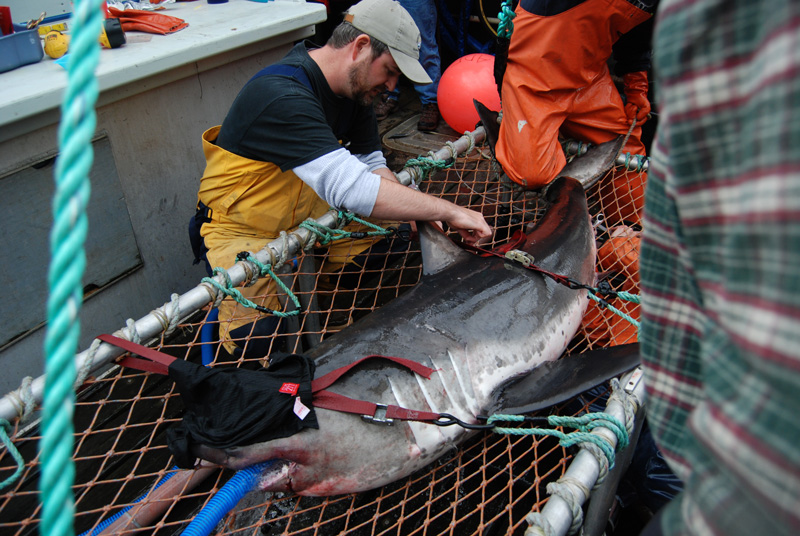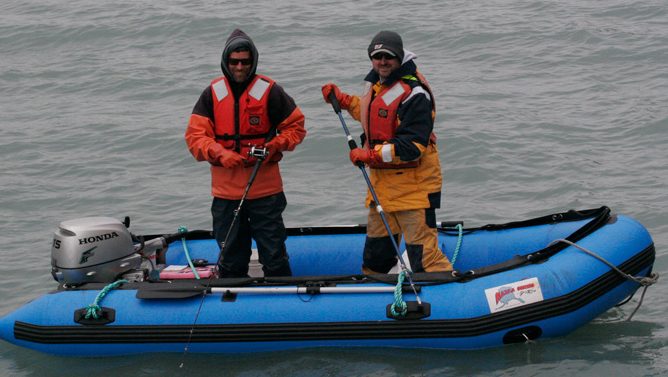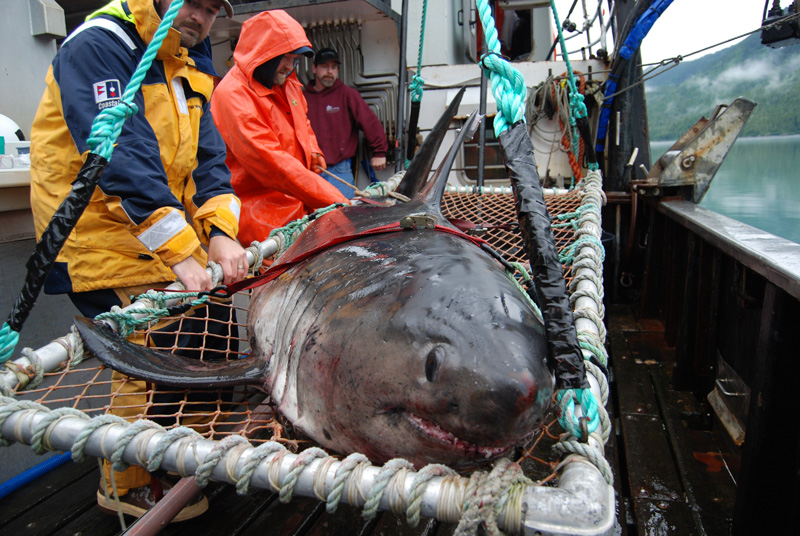


Tracking marine predators
Photos courtesy of Jack Musick and Scot Anderson October 05, 2018
UD’s Aaron Carlisle helps research salmon shark travel patterns
The University of Delaware’s Aaron Carlisle, assistant professor of marine biosciences, was recently a co-author on a paper published in the Nature Ecology and Evolution that is titled, “Political biogeography of migratory marine predators.”
During their migrations, marine predators journey across many bodies of water, travelling through multiple countries’ jurisdictions and across ocean basins. Some of these species are declining in part because of a failure of international agreements to ensure effective cooperation by the stakeholders responsible for managing species throughout their ranges, including the high seas — areas of the open ocean that are not within any single country’s jurisdiction.
Carlisle’s role in the study took place during his doctoral and postdoctoral work at Stanford University where he was part of the Tagging of Pacific Predators (TOPP) project, which was funded by the Census of Marine Life. Carlisle helped lead the tagging and tracking efforts of the salmon shark — one of 14 species included in the paper.

Q: Where did you find that the salmon sharks were travelling during the course of your research?
Carlisle: If you look at any of the species studied in the paper, they all have their own unique life history strategies and migratory routes. When this project started, we really had very little idea what these animals were doing for the most part. It turns out that salmon sharks are highly migratory and pretty much go wherever they want, with a remarkable diversity of migratory strategies. An animal could spend three years in Alaska and the next year go to Hawaii. Another animal could go and spend three years in California and Mexico and then come back to Alaska and the Bering Sea. However, there were some generally consistent patterns we saw over time.
With all these migratory animals, our historical understanding has been based on when we can see and access them, which is generally quite limited. For salmon sharks, we’d tag them in Prince William Sound, Alaska, when they would show up to eat the salmon that were coming back to their native rivers to spawn. The only reason we could start tagging them was because they started to predictably show up in high enough numbers in a particular area. Without that, you just don’t come across them often. You encounter them occasionally but it’s hard to do an actual scientific study on them when they’re so hard to access most of the time.
Q: How many sharks did you tag?
Carlisle: From 2006 to 2012, we tagged probably on the order of over 200 sharks. That was with a combination of satellite tags and acoustic tags and different types of tags. Only the sharks tagged with satellite tags were used in this study — which was 113.
Q: What are some of the difficulties that go into tracking and tagging these sharks?
Carlisle: Historically, there’s been a huge range of difficulties. First of all is just finding them. That’s a big hurdle that many people don’t consider. During the course of their migrations, the animal has to show up somewhere where scientists can actually access it.
Once we find them, we can figure out what can we learn from them. Historically, if we want to understand movement patterns, we’d do tag and release. We’d put little identification tags on them so that if they were re-captured, we’d get the date and position of where it was caught, which tells us a point to point movement, but it doesn’t tell us where it was in between those positions. It still provides some basic insight into their distribution as well as how much it’s grown.
In terms of actually understanding the movements, it wasn’t until the mid to late ’90s with the increasing miniaturization of electronics and other technological advances that allowed us to build increasingly smaller tags with more powerful battery systems to power them. Then we were able to start developing electronic tag packages that could be applied to the animals and have them stay on the animals for an extended period of time.
We tagged sharks with a variety of tags, however it was satellite tags that allowed us to track their broad scale movements. We attached fin-mounted tags, called SPOT tags, which transmit to orbiting Argos receivers on satellites, providing us with a high-resolution location whenever the shark’s fin broke the surface. We also used pop-off archival transmitting tags, PAT tags, which record light, depth, and temperature data every few seconds for some programmed length of time, generally 6 months to one year, before the tag detaches from the animal, floats to the surface and transmits summaries of those data to orbiting Argos receivers. We can then use the light data to reconstruct the movements of the sharks using light-based geolocation algorithms, much like sailors have done for centuries, and the temperature and depth data to understand its depth and temperature preferences.
Another big problem is keeping the tag on an animal. These animals are very hydrodynamically efficient. They’re fast, highly active predators, some of them jump out of the water, which makes keeping a tag on them problematic. On top of that, the ocean is a very hard place to be in an electronics package. Things grow on you. You get biofouling, where barnacles, algae, and other organisms grow on and cover the tag, producing so much drag it can break the tag, cover the sensors, or rip the tag off an animal. So just keeping a tag on an animal, and keeping it working, has been a whole area of research in and of itself, and you want to do it in a way that minimizes the impact on the animal. You don’t want to hurt the animal, or alter its behavior, otherwise there’s no point to doing the research.
Q: Why is it important to know where these creatures are travelling?
Carlisle: We’re interested in effectively managing marine resources and conserving threatened species, but how do you do that when they’re spending so much time in the open ocean and moving across jurisdictional boundaries? These animals are moving over huge areas and crossing the territories of many different countries which may or may not be managing these species, so these migration patterns have important management implications.
We are learning that there’s really no parts of the world’s oceans that aren’t being fished intensively. When you’re thinking about something that is potentially threatened like a leatherback sea turtle, if you’re going to manage it and conserve it, you need to know what and where the threats are. The leatherback sea turtle is moving through the jurisdictions of 32 countries over the course of their migrations, so how do you manage that species? You have to have international relationships and agreements to effectively do that. Bluefin tuna move from Japan to California and back. If you’re going to manage it, what the California fishermen do impacts the Japanese fisheries and vice versa so you have to have these international efforts to effectively conserve and manage these migratory species.
The reality is that for any of these animals that are moving around, you can’t manage them in a single jurisdiction. You need to have multi-jurisdictional efforts, and you have to get a handle of what’s going on in the high seas, because the more we learn about what is going on out there the more we’re realizing that it’s the Wild West. There was actually a conference at the United Nations earlier this month that addressed how to manage high seas fisheries and resources, so we are hopeful that we’ll start to get a handle on this important problem.

Contact Us
Have a UDaily story idea?
Contact us at ocm@udel.edu
Members of the press
Contact us at 302-831-NEWS or visit the Media Relations website

